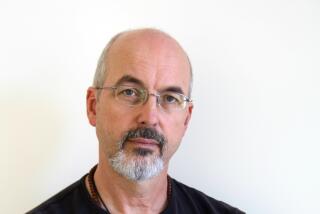‘RADIO ART’ SERIES DUE ON KUSC-FM
- Share via
Just when you thought you were beginning to understand performance art, it’s time to deal with another contemporary aesthetic-- radio art.
Last month, the Museum of Contemporary Art launched “The Territory of Art II,” its second series of programs created for radio. The show will air over more than 300 public radio stations nationwide through March 30, and locally on Mondays at 10 p.m. on KUSC-FM.
The 13-week series, produced in association with KUSC, includes segments ranging from a mock epic poem to the portrait of an expatriate South African artist. A MOCA press release says the series “is not about art, it is art,” calling each piece “radio art.” But just what might that be?
“My old definition of performance art was anything you did as long as you didn’t make money doing it,” says Ilene Segalove, co-writer, with Paul Krassner, of “TV Times,” the series’ forth program airing Monday. “Radio art is consistent with that.”
“This felt like art to me because I was doing it as an act of communication, not as a foreplay to a commercial,” Krassner added. “And I wrote without any censorship. Also, the program stimulates the imagination and feelings.”
Segalove, 36, has been making videos since 1971, using that medium to comment satirically on popular culture, particularly on television’s impact on society. Last year she won the County Museum of Art’s prestigious Young Talent Purchase Award, and for the last two years has written radio commentaries for National Public Radio.
“It was like a freedom, discovering that I could work in radio,” said Segalove. “Also, I just love that radio just slides into people’s lives, rather than having to formally sit down and watch video art as if it were some elitist art form.
“Anyway, I don’t worry whether or not something is art or not anymore. With ‘TV Times,’ I just wanted to tell a story that could be surreal and kind of funny and personal.”
Segalove’s contributions to the program, a humorous exploration of “the curious, outrageous and sometimes fatal relationships between individuals and their TV sets,” indicate the depth of her relationship to the medium.
In one segment, she recalls her first assignment in Jewish nursery school. Asked to draw her concept of God, she sketched the CBS eye logo. Next, she describes how, as a teen-ager, her boyfriend’s appearance on “The Dating Game” triggered their painful break-up. Both are true stories, Segalove said.
“I grew up always watching TV,” she affirmed. “I never went to boy-girl parties. I’d wash my hair and make fudge cake and watch ‘Chiller’ with my brother. And I really thought that if my mom wore pearls and a shirtmaker dress like Donna Reed, she really would be nice . . . Still, I don’t think TV made more of an impact on me than on other people; I’m just willing to admit it.”
In contrast, Krassner, 54, said he grew up with radio. However the stand-up performer and founder/editor of the leftist publication Realist, acknowledged TV’s influence on society.
His contribution to “TV Times,” produced and directed for MOCA by Stephen Proffitt, is the tale of a female “TV junkie” who undergoes “hypnotic age regression” therapy after shooting her set with a gun.
“I became aware that the most widespread addiction in this country was TV itself,” said Krassner, who said he gave the 1960s Yippie movement its name (and was one). “Then I heard that Elvis Presley shot his TV, and a lot of my friends felt like they wanted to do that. So, I tried to probe into that collective unconsciousness” and thus placed the TV junkie into therapy.
“Kids learn an incredible number of things from TV, including certain moral perceptions--even before they learn how to speak English,” Krassner continued. That notion, he said, inspired him to have a child in his segment say, “Meow, meow, meow, meow,” mimicking a cat-food commercial as she utters her first words (words that drive her mother to shoot the family TV).
“I thought that kind of thing was possible--it’s in that borderline between possible and probable. In fact, and this may be an apocryphal story because it came to me second hand, but I once heard of a kid whose first words were, ‘Stay tuned . . . ‘ “
More to Read
The biggest entertainment stories
Get our big stories about Hollywood, film, television, music, arts, culture and more right in your inbox as soon as they publish.
You may occasionally receive promotional content from the Los Angeles Times.










